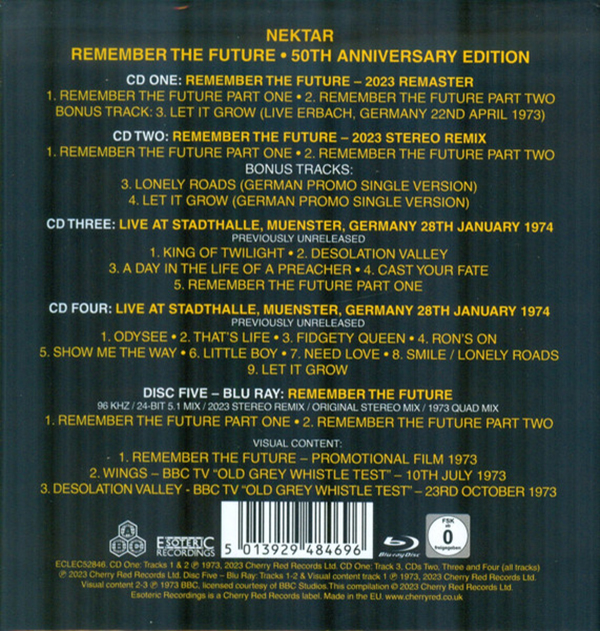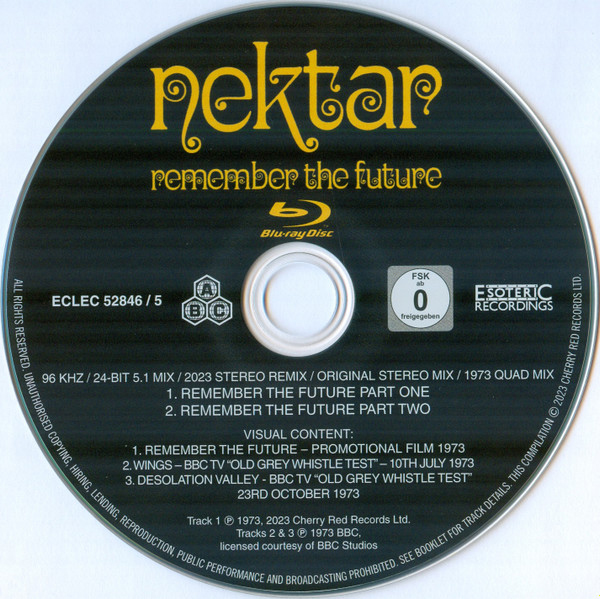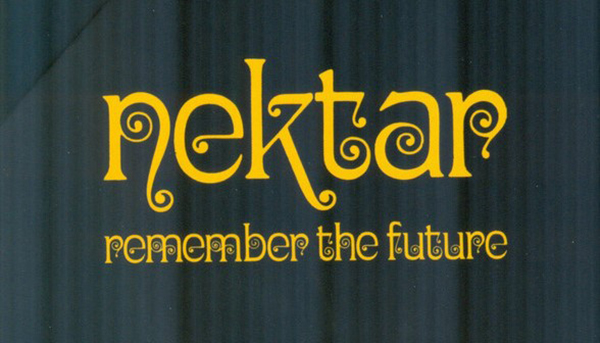Ben Wiseman on Remixing Nektar’s Forward-Thinking 1973 Masterpiece Remember the Future in 5.1 (and More)

British mixing engineer Ben Wiseman has a C.V. that more than mirrors the sagacity implied by his given surname. Among his many mix/remix and master/remastering production-related projects of the past two decades include albums from the likes of Soft Machine, Man, Curved Air, Hawkwind, Barclay James Harvest, Tangerine Dream, and Nektar (to name but a few). You’d think that, given just that short list of major artists, Wiseman lays claim to a deeply rooted progressive pedigree—but you’d be surprised.
“I didn’t grow up in that prog era—I’m really a kid of the ’80s and ’90s,” Wiseman admits, “and I love my underground rock and metal of that ’80s, ’90s era. When I moved to Bristol [in South West England], then I started listening to the Bristol [underground scene] sound. Yeah, my music taste has been all over the place.”
Once Wiseman began working with Mark Powell, the noted British rock archivist, co-label owner, and a fine surround-sound producer in his own right, Wiseman joined the prog fold (so to speak). “When I started working with Mark, it was really interesting to uncover a load of bands I’d never even heard before, or even thought about listening to before,” Wiseman continues. “Compared to some people, I come to most of this stuff as a fresh set of ears, and as someone who’s got no preconceptions about these bands.”
That truly fresh background may be the key reason behind why Wiseman’s surround-centric remixes for the above-mentioned progressive artists are among the most interesting in the field. A perfect example is Wiseman’s recent 5.1 remix for the 50th anniversary box set brick for Nektar’s fourth studio album, Remember the Future, which was originally released in November 1973 on Bacillus/Bellaphon. Building on the expansive outreach of Nektar’s first three LPs—November 1971’s Journey to the Centre of the Eye, November 1972’s A Tab in the Ocean, and June 1973’s Sounds Like This—Future went all-in on the band making a concept album that appears as one continuous piece, albeit as a designated title track spread across two sides in multiple movements encapsuled within two cohesive parts.

The 2023 Future cube came courtesy Powell’s own always trustworthy and worth-every-shekel Esoteric Recordings label in November 2023, and it includes five discs in total—four CDs (one with Wiseman’s new remaster, one with his new stereo remix, and two with of-era live material), and a fifth, Blu-ray disc featuring Wiseman’s new 24-bit/96kHz 5.1 mix along with his 2023 stereo remix, the original 1973 stereo mix, the original 1973 quad mix, and a score of visual-content extras to boot.
Yes, various others Future reissues also emerged over the ensuing decades, including a 2004 SACD from Dream Nebula Recordings/Eclectic Discs with a clever 5.1 mix done by the aforementioned Mark Powell and Paschal Byrne—a mix we discussed at some length in my Nektar-related S&V Interview column that posted here back on March 26, 2020—but there’s no contest that the 2023 Esoteric Recordings cube is the definitive edition.
To get inside Wiseman’s 360-degree headspace, he and I recently conducted a lengthy Zoom interview across The Pond. Here, Wiseman and I discuss how he initially attuned himself to Nektar’s music, the process of finding and incorporating discarded tracks when it was appropriate to do so, and how he tried to honor the album’s lyrical content with his remixes. Take a trip back in time / Life evolving, growing higher. . .

Mike Mettler: Before we get into the 5.1 Future of it all, tell me a bit more about your working relationship with Mark Powell.
Ben Wiseman: Mark and I are so used to working together now, and over the years, we’ve done loads of stuff. It started off as remastering, and then mixing bonus material—lots of bonus stuff that we found on multitracks. As you’re diving through the archives, you find things that have never seen the light of day like live gigs and early demo versions of finished tracks, so I did a lot of that sort of mixing through the years.
And now, it seems to be that labels are wanting to spend some money and do these big box sets to go back to certain things and do them properly—which is great for me. I’ve been expanding into these new areas ever since, about four years ago, I bought a 5.1 setup and started working on things in that format.
Mettler: Got it. Now tell me about how the 5.1 mix for the 50th anniversary release of Remember the Future got underway.
Wiseman: Originally, Nektar was just another project that Mark came to me with and said, “I’ve got an album for you to do in surround.” I didn’t really know anything about them until he sent it all over when I got the multitrack files on hard drive. And, straightaway, as soon as I loaded it up, I was trying to work out, “Oh, all the songs must be on a comp reel.” I hadn’t looked at the markup sheet—but when I did, I realized it was all one thing.
Mettler: Right. “Remember the Future” is essentially one track in four-to-ten movements. (both laugh)
Wiseman: Yeah. Exactly! (continues laughing) I was like, “Well, where do I chop this up?” As soon as I started listening to it and going through it, it was really quite daunting, because of that fact. I realized I had to “make friends” with the composition before I could go any further, and I started to listen to it in segments.
I’ve gone and opened up the session notes for this conversation so that I could look at it and remind myself of what I went through with it! (laughs) Now that I’m looking at it, I’m seeing where I put markers all the way through of where all the vocal sections are, and the bits that I could move into so that I could move around the whole project to know where I was. I’d look to where I put my cursor and think, “Okay, where does this bit go? Is it before that bit? Am I building into that bit, or am I building out of that bit?” That was the sort of thing I found quite hard on this project to start with. It was quite different from anything I’ve done before.

Mettler: Did you listen to the stereo reels first, or did you listen to the quad mix first before you started doing your thing with it? How did you approach it?
Wiseman: Sometimes, not everything happens chronologically, so I started the remixing project quite a lot before we did the stereos and the quad. When Mark sent over the multis, he sent the stereo as well. I put the stereo at the bottom of the track, and when I went into the more dense bits—well, when you haven’t mixed it [originally yourself] and you’re trying to work out what they’re thinking with the arrangement, you just refer straight to the stereo and think, “Oh, okay, now I get it.”
And then you try and work out what’s what, and what they’ve done. Occasionally, there’s the odd bit of some guitar they didn’t use in the finished mix, so then I’m thinking, “God, that doesn’t sound like the stereo! Where is that bit of guitar coming from?” I’m going through everything—soloing it, trying to find it—and then I listened to the stereo. That’s when I realized, “Well, that’s not the right bit. That shouldn’t be in there. That bit I’ve got isn’t in there.” And then I found the bit that should be there.
Actually, at the start of Side 1, there’s a solo they abandoned halfway through, and they instead faded in another solo that made me think, “How does that solo suddenly change?” They’d just taken two parts and manually, with the desk, cross-faded from one to another, and just banded together two halves of two different solos.

Mettler: Yeah, and the way they recorded it, which was a short session period—just a couple of days long, I think, as was referenced in the liner notes— maybe that helped Future to be as “open” as it is, and not as dense as some of their other recordings are.
That also gave you a lot of space to work in, naturally. For example, when you cue up the Blu-ray and that “swirling” menu comes up on the screen where stuff starts moving around in a circular fashion, you actually give us the aural equivalent right at the beginning of “Part One.” We get some bass content in the middle before the guitars pan out—which is very different from the stereo mix, where there’s something’s over here [points to the left] and something over there [points to the right]. It almost seems like it’s too much to contain just in stereo—and in the surround mix, we get the full panorama. It really opens up.
Wiseman: Yeah, well, that little intro you’re talking about is the cymbal, the backwards organ, the guitar, and other stuff at the start. And that was great to work with, because when you get bands like Hawkwind, you can really sort of go mad with the swirling stuff. Whereas, because this Nektar album has more song-based material, you can have some things moving—but since, most of the time, there are so many great vocals and vocal tracks, and it’s also guitar-driven, you kind of want to leave it where it is to drive itself. You don’t need to come up with anything crazy.
But at the start, you’ve got these little bits in the middle, and where I could start automating the pans around. That weird bit at the start with the guitar-neck pluck and the other stuff that’s there—that was all really good to work with. (smiles)

Mettler: Yeah, yeah, that was a nice touch. And it doesn’t sound—I mean, sometimes, when people do what I’ll call “full rotation,” it can sound gimmicky. What you’ve done here in surround fits the vibe of what the whole theme of the record is about. You’re setting us up to get into what Nektar wind up talking about on both parts of the song. It’s earned, right out of the box, and it sets the table for how Nektar takes us around the planet in the lyrics, as it were.
Wiseman: That’s quite the theme they have there, yeah. I was trying to follow the lyrics as I was working on it. It seemed a bit crazy, and it wasn’t until after I’d finished that I looked it up. I mean, I had my own idea of what the album was talking about, but I wasn’t really sure. They had loads of really cool lyrics there, but I didn’t really pick up an exact sort of meaning of it all until afterwards when I started reading the concept of the whole thing—and then I understood the whole of it.
Mettler: Same here. When I sat down to listen to your surround mix and was re-acclimating myself with the album and the lyrics, I was like, “Oh, the bigger themes are still relevant, 50-something years later—and they’re still not solved.”
Wiseman: Yeah, absolutely. Absolutely. I knew it was a prog album and it was all one side for each song half. I was a bit nervous before I got into it because I thought it was going to just be full of extended solos, but I was surprised at how catchy it is. Oh, I dunno if that’s the right word—I was surprised at how accessible it is.
Mettler: Yeah. I think that’s totally fair. You almost feel like you could break up each side into a bunch of four-minute segments, like earmarking the “Let It Grow” section at the very end of “Part Two” as a single, in order to set the table.
Wiseman: Absolutely. Now, in lookin at my surround session notes here, after that bit at the start, I noticed that I automated that guitar in time to where it moves from one speaker to the other, almost like it’s got a Leslie [cabinet] feel. I didn’t do it any further than just that bit because I didn’t want to muddy the waters too much.














































